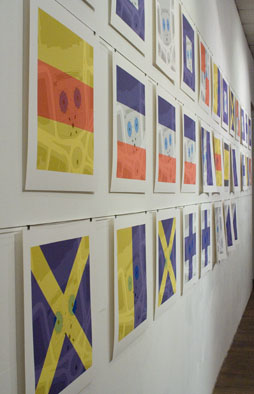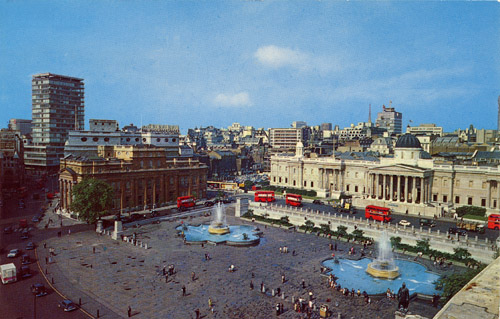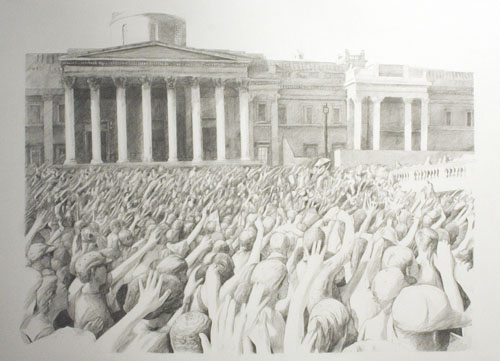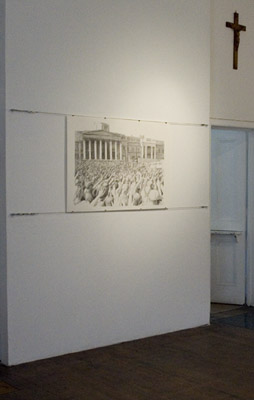Trafalgar
T1+2 Gallery , London, 2007
'Trafalgar' exhibition installation shot
Trafalgar square contains the point from which all measurements to and from London are taken. It provides a centre for collective national protest and celebration - a mirror to civic life in the UK and a prime tourist destination. In recent years the Greater London Authority has financed a campaign to soften its image and make its symbolism more inclusive, denoting associations of dirty pavements and 19th century heroes. Eva Bensasson’s second solo show at T1+2 Gallery explored key elements that imbue Trafalgar Square with its iconic status. This exhibition referenced recent attempts to make Trafalgar Square into a cultural arena and invited discussion of the relationship between popular space-forming and government sanctioned culture.
England Expects That Every Man Will Do His D U T Y
(detail), Glicee prints, 2007
Bensasson recreated Nelson's famous signal on the eve of the battle of Trafalgar —‘England Expects That Every Man Will Do His Duty’. Using the numeric flag code that Nelson’s signal officer employed in 1805 to spell out the phrase, Bensasson superimposed each flag over a recent aerial plan of the square. This phrase helped elevate Nelson to the position of one of the most revered national heroes and the inspiration for the creation of Trafalgar Square. The phrase has often been paraphrased, in the present day increasingly for its anachronistic quality. The expectation of ‘duty’ at time of war has become deeply problematic and it is significant that in 2003 Trafalgar Square saw the Anti War protest, the UK’s largest ever political demonstration. The repeated plan of an empty square serves to re-pose a question about its physical presence. Since the Chartists’ demonstration in 1848, a range of measures have been mobilised to control the flow of people through the space. The very introduction of the fountains was intended to limit the square’s capacity. The plan Bensasson used is of the square since it’s ‘relaunch’ in 2002, the emphasis of which was to control pedestrian movement through the square. The aerial viewpoint is notable and compelling for its cleanliness, its removal from the mess of everyday life. References to Nelson’s ‘England Expects…’ appear throughout James Joyce’s Ulysses, with each repetition giving another spin on its meaning. By using the signal flags, with their resemblance to country flags, this work also raised questions about social movements and national identity.
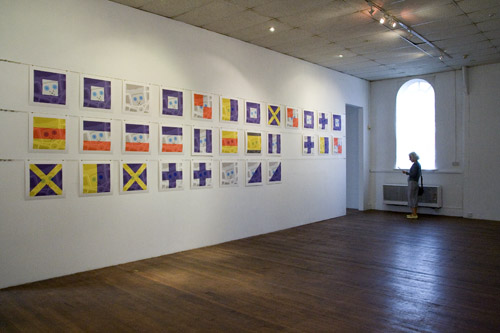
England Expects That Every Man Will Do His D U T Y, Glicee prints, 2007
'Trafalgar' exhibition installation shot
Villeneuve, Glicée print, 2007
Villeneuve is a Glicée print enlargement of a 1970s postcard of Trafalgar Square, with Nelson’s Column removed. Pierre-Charles Villeneuve was the naval officer in command of the French and Spanish fleets during the Battle of Trafalgar. His remarkable actions, both before and during the battle, have been said to have significantly contributed to French defeat. This work is a consideration of an alternative London, following a French invasion, where Villeneuve has become the hero. The simple removal of the column serves to make the square more reminiscent of a French place. More obviously, the title plays with the idea of the square as part of a ‘new town’, yet set in the 1970s it is also definitely past.
Soul in the City, graphite drawing, 2007
Soul in the City is a pencil drawing based on a photograph of an event of the same name that took place in Trafalgar Square in August 2004. This was a Christian faith based event supported by Tony Blair. The image was chosen due to the ambiguous nature of the event portrayed, as possibly celebration or political demonstration, two activities that characterise the square.


